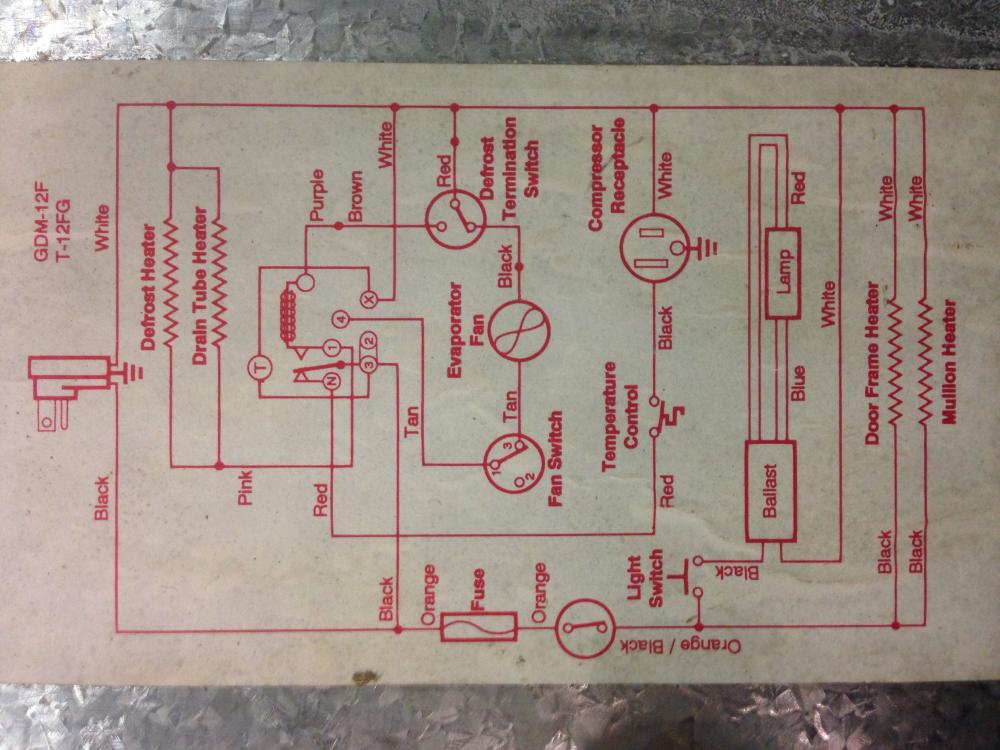
For accurate and concise troubleshooting information for your True Refrigerator, consult the official True Refrigerator Troubleshooting Manual. This manual provides detailed instructions and solutions for common issues with your refrigerator, ensuring efficient and effective troubleshooting.
Properly troubleshooting your refrigerator can save time and money by avoiding unnecessary repairs or replacements.

Credit: www.reddit.com
Common Issues With True Refrigerators
Troubleshooting common issues with True Refrigerators is made easier with the True Refrigerator Troubleshooting Manual. This comprehensive guide helps users identify and resolve problems, ensuring optimum performance and longevity for their refrigeration units.
Refrigerator Not Cooling Properly
If your True refrigerator is not cooling as it should, it can be quite frustrating. There are a few potential reasons why this might be happening. First, check the temperature settings on your refrigerator. Ensure that it is set to the appropriate temperature for optimal cooling. If the settings are correct, the next thing to check is the condenser coils. Over time, dust and debris can accumulate on the coils, hindering their ability to release heat. Clean the coils regularly to ensure proper cooling.
Another common reason for inadequate cooling is a faulty door seal. Inspect the seal for any cracks or gaps that may be preventing a tight seal when the door is closed. Air leaks can cause the refrigerator’s temperature to rise and affect its cooling efficiency. If you notice any issues with the door seal, it is recommended to replace it.
Remember, proper cooling is vital for food safety and to maintain the freshness of your groceries. If the issue persists despite troubleshooting these common causes, it is advisable to seek the assistance of a professional technician.
Ice Build-up In The Refrigerator
If you find ice build-up in your True refrigerator, it can be an indication of an underlying problem. One possible cause is a clogged or malfunctioning defrost drain. Over time, debris and ice can accumulate in the drain, preventing proper drainage and causing water to back up into the refrigerator. To resolve this issue, locate the drain and clean it out using a mixture of warm water and mild detergent.
Another cause of ice build-up is a faulty gasket or door seal. A damaged or worn-out gasket can allow warm air to enter the refrigerator, causing moisture to condense and ice to form. Check the gasket for any signs of damage and replace it if necessary.
To prevent ice build-up, it is important to defrost your refrigerator regularly. Follow the manufacturer’s instructions for defrosting your True refrigerator to ensure it operates efficiently and to avoid ice-related issues in the future.
Strange Noises Coming From The Refrigerator
If your True refrigerator is emitting unusual noises, it can be quite disturbing. These sounds can indicate underlying issues that require attention. One common cause of strange noises is a faulty condenser fan. The condenser fan is responsible for circulating air across the condenser coils to facilitate heat release. If the fan is damaged or not functioning properly, it can make rattling or grinding sounds. It is advisable to consult a technician to inspect and replace the fan if necessary.
Another possible reason for strange noises is a malfunctioning evaporator fan. The evaporator fan circulates cold air throughout the refrigerator to maintain an even temperature. If the fan motor or blades are faulty, it can create a variety of noises, such as squealing or humming. A professional technician can diagnose and resolve the issue with the evaporator fan.
Remember, unusual noises from your refrigerator should not be ignored, as they can be indicators of more significant problems. Contact a professional technician if you encounter any strange sounds coming from your True refrigerator.
Credit: true-residential.com
Troubleshooting Steps
When your True refrigerator is not functioning properly, it can be frustrating and disruptive. However, before you call a service technician, it’s worth going through a few troubleshooting steps to identify and potentially resolve the issue on your own. Below are some common troubleshooting steps that can help you diagnose and fix minor problems with your True refrigerator.
Check The Temperature Settings
One of the first things you should check when troubleshooting your True refrigerator is the temperature settings. Incorrect temperature settings can lead to cooling problems. To do this:
- Locate the temperature control dial inside the fridge or freezer compartment.
- Ensure that the dial is set at the recommended temperature, which is usually between 34°F and 40°F for the fridge section, and 0°F for the freezer section.
- Adjust the dial if necessary, making sure to wait a few hours for the temperature to stabilize before checking if the issue has been resolved.
Clean The Condenser Coils
Dirty condenser coils can restrict airflow, causing the refrigerator to work harder to maintain the desired temperature. Cleaning the condenser coils can improve the overall performance of your True refrigerator. Here’s how:
- Locate the condenser coils, which are typically located at the back or bottom of the fridge.
- Use a vacuum cleaner with a brush attachment to gently remove dust, dirt, and debris from the coils.
- Ensure that the coils are thoroughly cleaned, and then close the access panel.
- Restart the refrigerator and monitor if the cooling improves.
Inspect The Door Gasket
A faulty door gasket can result in air leaks, causing the refrigerator to lose its cooling efficiency. To inspect and potentially replace the door gasket:
- Close the fridge door and visually inspect the gasket for any signs of wear, tears, or damage.
- Run your hand along the gasket to feel for any air escaping.
- If necessary, clean the gasket with mild soapy water and a soft cloth.
- If the gasket is damaged or ineffective, contact True Refrigeration’s customer service for a replacement gasket or professional assistance.
Clear Clogged Drain Tubes
Blocked or clogged drain tubes can lead to water leakage and ice buildup inside the refrigerator. To clear the drain tubes:
- Locate the drain tube at the back of the refrigerator or inside the freezer compartment.
- Use a long, flexible brush or pipe cleaner to gently remove any debris or obstructions from the tube.
- Once cleared, pour a mixture of warm water and mild detergent down the tube to flush out any remaining residue.
- Verify that the water is draining properly and that there are no signs of leakage or ice formation.
Replace Faulty Fans Or Motors
If your True refrigerator is still experiencing issues after checking the temperature settings, cleaning the condenser coils, inspecting the door gasket, and clearing the drain tubes, there may be an issue with the fans or motors. To replace faulty fans or motors:
- Identify the specific fan or motor that may be causing the problem. Refer to the True refrigerator’s manual for guidance.
- Contact True Refrigeration’s customer service for replacement parts or assistance with locating a service technician.
- Follow the manufacturer’s instructions to safely and correctly replace the faulty component.
- Once the replacement is complete, monitor the refrigerator’s performance to ensure that the issue has been resolved.
Preventive Maintenance Tips
When it comes to keeping your True refrigerator in top-notch condition, regular preventive maintenance is crucial. By following a few simple maintenance tips, you can extend the lifespan of your refrigerator, optimize its performance, and prevent costly breakdowns. In this section, we will explore some preventive measures that you can take to ensure your True refrigerator functions smoothly for years to come.
Regularly Clean The Refrigerator
One of the most important aspects of preventive maintenance for your True refrigerator is regular cleaning. Over time, dirt, dust, and food particles can accumulate in various parts of the refrigerator, affecting its performance and efficiency. To prevent this, make it a point to clean your refrigerator at regular intervals.
Here are a few steps you can follow:
- Remove all the contents from the refrigerator and store them in a cool place.
- Switch off the refrigerator and unplug it from the power source.
- Use a mild detergent mixed with warm water to clean the interior of the refrigerator. Pay special attention to the shelves, door gaskets, and drawers.
- Wipe down the exterior of the refrigerator with a clean cloth.
- Once you have cleaned all the components, allow them to dry completely before plugging in the refrigerator and returning the contents.
Monitor The Temperature Regularly
Maintaining the right temperature is essential for preserving the freshness of your food. Therefore, it is vital to periodically monitor the temperature of your True refrigerator to ensure it is functioning optimally.
Follow these steps to monitor the temperature:
- Locate the temperature control panel of your refrigerator, usually situated inside the main compartment.
- Use a thermometer to check the temperature.
- If the temperature is not within the recommended range, you may need to adjust the settings. Refer to your True refrigerator troubleshooting manual for detailed instructions on how to adjust the temperature.
Avoid Overloading The Refrigerator
Proper storage of food items is crucial to ensure efficient cooling and prevent strain on the refrigerator’s components. Avoid overloading your True refrigerator by following these tips:
- Do not place hot or warm food directly into the refrigerator. Allow it to cool down to room temperature before storing.
- Avoid overcrowding the shelves, as this can impede proper airflow and result in uneven cooling.
- Ensure that the door can close tightly without any obstructions. Overstuffing the refrigerator can prevent the door from closing properly, leading to energy wastage and compromised cooling.
By following these preventive maintenance tips, you can keep your True refrigerator in optimal condition and avoid potential issues in the future. Regular cleaning, monitoring the temperature, and avoiding overloading are simple measures that can go a long way in ensuring the longevity and efficiency of your refrigerator.

Credit: www.refmech.com
Frequently Asked Questions Of True Refrigerator Troubleshooting Manual
How Do I Reset My True Refrigerator?
To reset your True refrigerator, locate the power switch at the back or bottom of the unit, switch it off, wait for 30 seconds, and then switch it back on. This will reset the refrigerator and resolve many common issues.
Why Is My True Refrigerator Not Cooling?
There can be several reasons why your True refrigerator is not cooling. Check if the temperature settings are correct, ensure the condenser coils are clean, and make sure the door is closing properly. If the problem persists, it could be a sign of a malfunctioning compressor or refrigerant leak, requiring professional assistance.
How Often Should I Clean My True Refrigerator’s Condenser Coils?
To keep your True refrigerator running efficiently, clean the condenser coils every six months. Dust and debris can accumulate on the coils, reducing the cooling capacity of the unit. Use a vacuum cleaner or a soft brush to gently remove any dirt or dust from the coils.
Regular cleaning will help maintain optimal cooling performance.
Conclusion
This True Refrigerator Troubleshooting Manual provides a comprehensive guide to diagnosing and resolving common issues with your refrigerator. By following the step-by-step instructions and helpful tips outlined in this manual, you can save time and money on costly repairs. Whether it’s a faulty thermostat, a clogged condenser coil, or a malfunctioning compressor, this manual has got you covered.
Keep this manual handy for future reference and never let a refrigerator problem ruin your day again.






